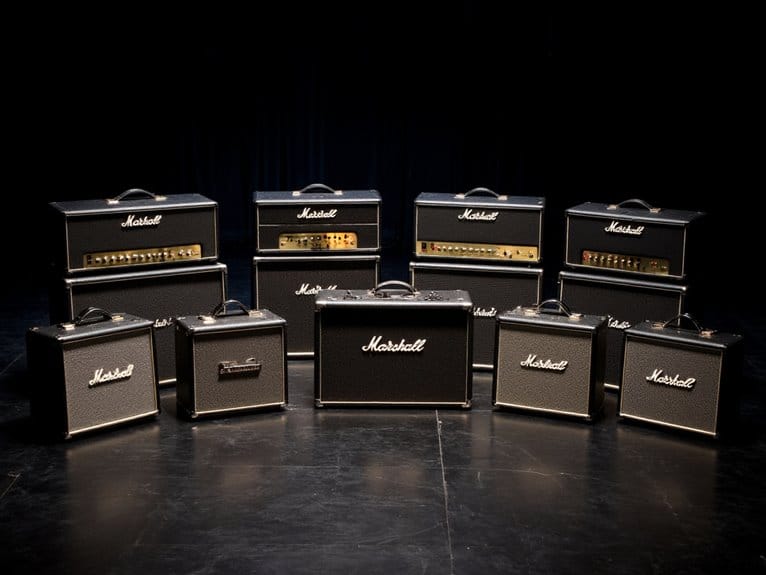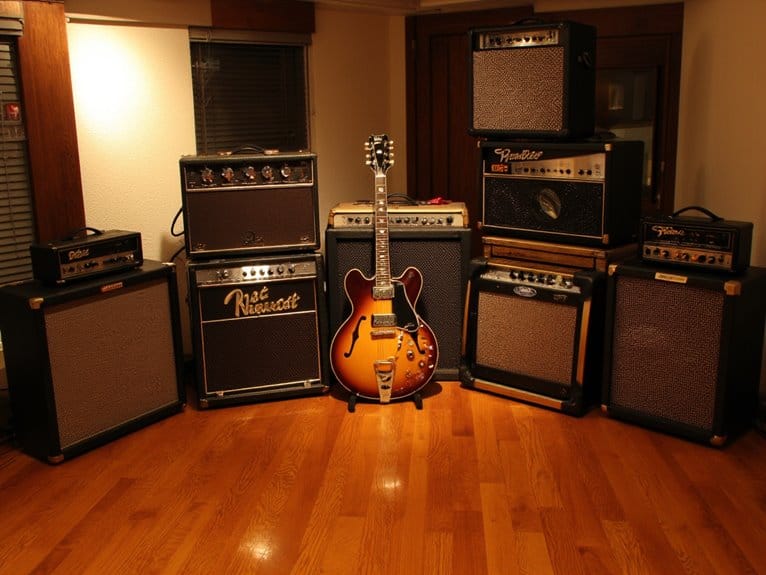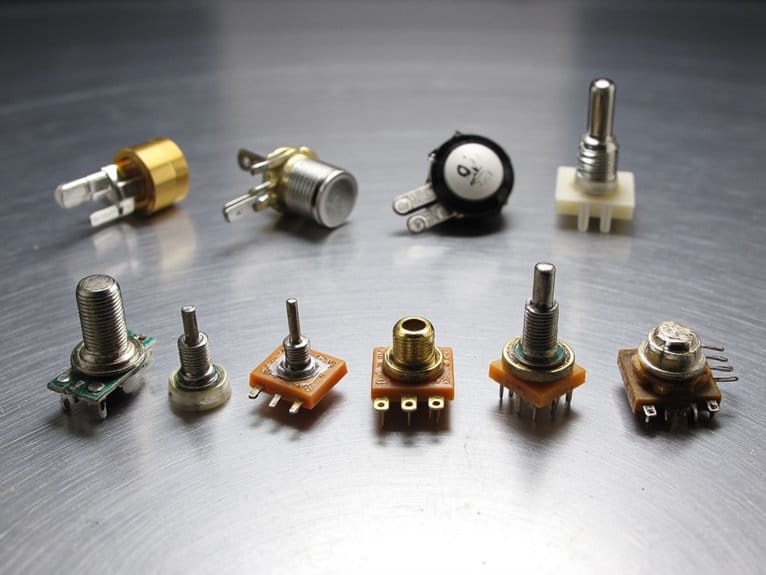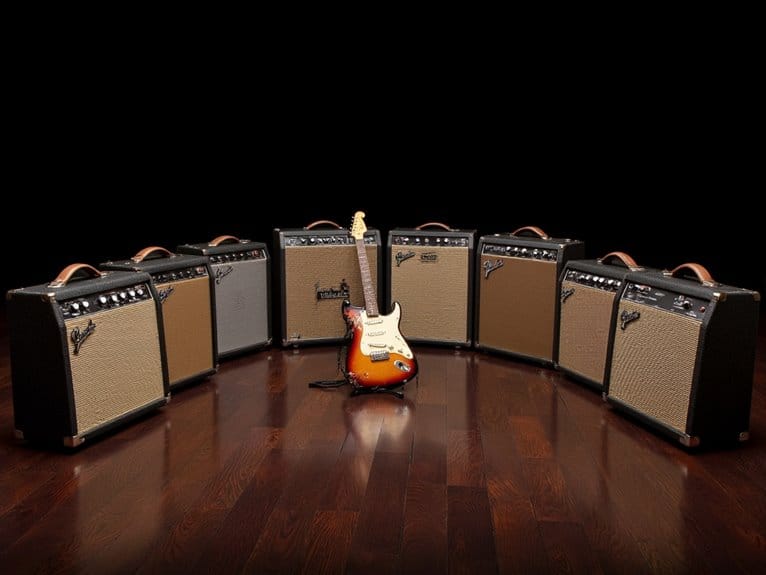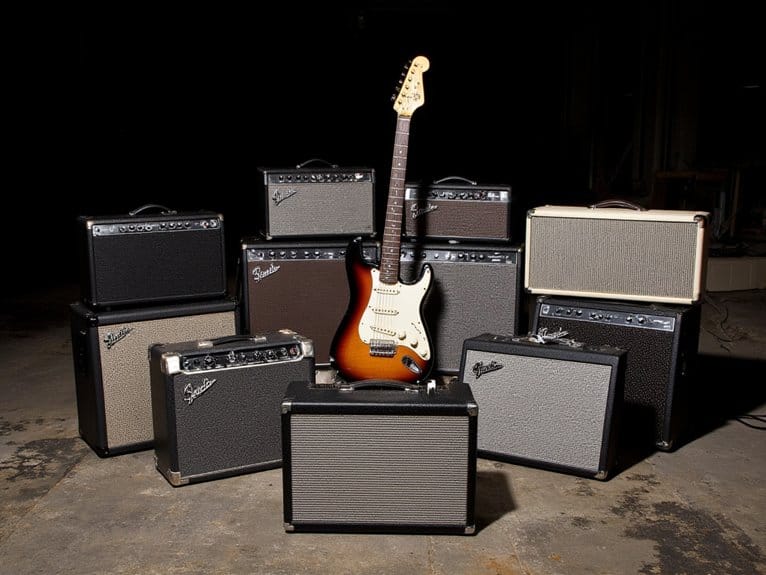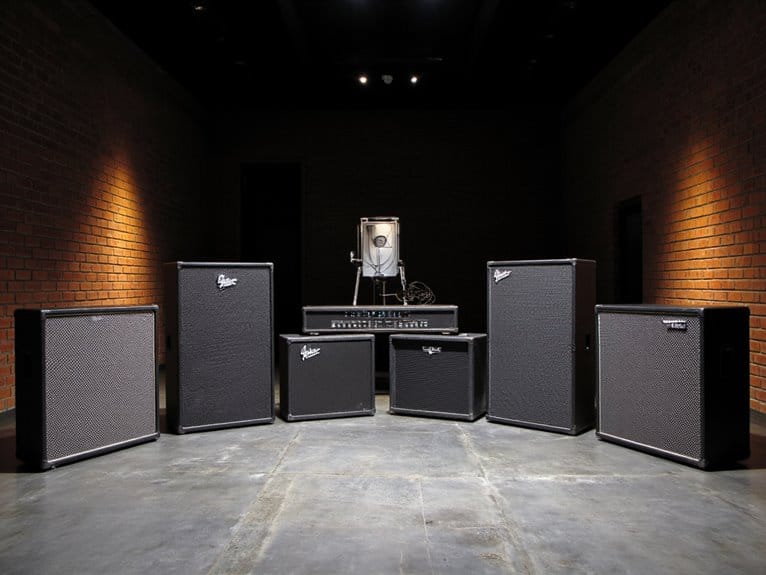Best Marshall Combo Amps – Power and Classic Tone
Marshall’s 2025 combo lineup delivers that iconic British crunch across every wattage range, from the portable 10-watt MG10G-U perfect for apartment practice to the versatile 30-watt MG30GFX-U with four distinct channels. I’ve found the MG15GFX offers the best value with built-in effects like reverb and delay, while the battery-powered MS2 provides genuine Marshall tone anywhere. Each model features headphone outputs for silent practice and auxiliary inputs for backing tracks, ensuring you’ll discover the perfect balance of power and portability below.
We are supported by our audience. When you purchase through links on our site, we may earn an affiliate commission, at no extra cost for you. Learn more.
Notable Insights
- The Marshall M-MG30GFX-U delivers 30 watts with four channels and custom 10-inch speaker for versatile practice amplification.
- Marshall M-MG10G-U provides classic overdrive tone in a lightweight 10-watt package with minimal noise for apartment use.
- Marshall MG15GFX offers four distinct channels with built-in effects including reverb, chorus, and delay in compact 15-watt design.
- Marshall MS2 delivers portable battery-powered genuine Marshall tone with clean and overdrive channels in ultra-compact size.
- Higher wattage doesn’t guarantee better tone; 10-inch speakers provide fuller sound while 30+ watts balance practice and venue performance.
Marshall Amps Guitar Combo Amplifier, 3.5mm Jack, Black (M-MG30GFX-U)
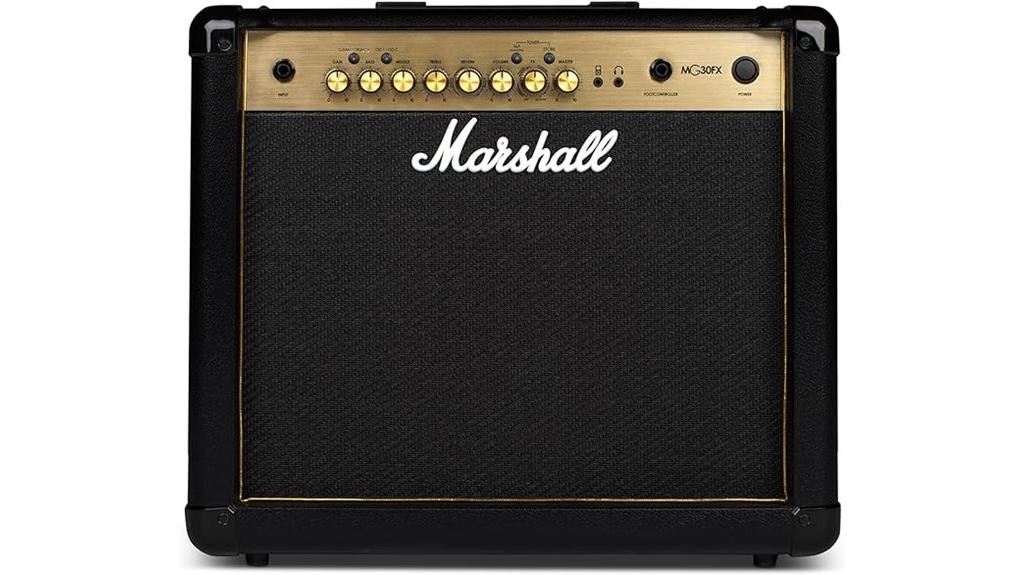
The Marshall M-MG30GFX-U stands as the quintessential choice for guitarists who need versatile practice amplification without breaking the bank, delivering that coveted Marshall tone in a compact 30-watt package. You’ll find four distinct channels—clean, crunch, OD1, and OD2—paired with a custom 10-inch speaker that produces surprisingly rich sound for its 23.8-pound frame. The emulated headphone output lets you practice silently without disturbing neighbors, while the 3.5mm line input accommodates backing tracks for jam sessions. With digital effects built-in and 4.6 stars from 442 customer ratings, this amp proves that quality Marshall engineering doesn’t require massive investment.
Best For: Beginning to intermediate guitarists who need a versatile, affordable practice amplifier with multiple channels and silent practice capabilities for home use and small jam sessions.
Pros:
- Four distinct channels (clean, crunch, OD1, OD2) with built-in digital effects provide excellent tonal versatility for the price point
- Emulated headphone output enables silent practice without sacrificing sound quality
- Compact and portable at 23.8 pounds while still delivering quality Marshall tone through a custom 10-inch speaker
Cons:
- 30-watt output may be insufficient for larger venues or band performances with drums
- Limited to 3.5mm auxiliary input which may require adapters for some devices
- As a budget-friendly option, it may lack some advanced features found in higher-end Marshall amplifiers
Marshall Amps Guitar Combo Amplifier, 3.5mm Jack, Black (M-MG10G-U)
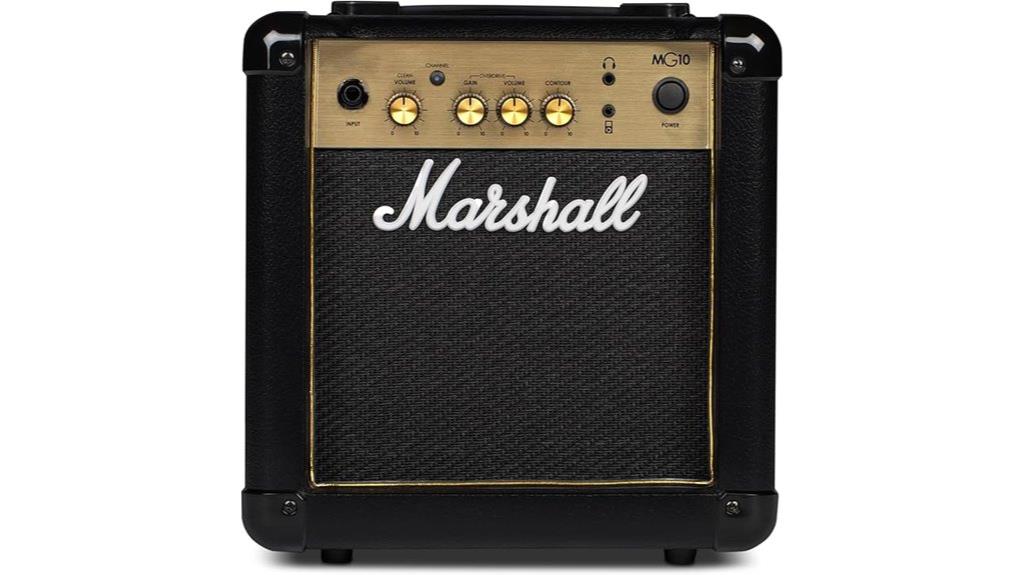
Budget-conscious beginners who demand genuine Marshall tone without breaking the bank will find their perfect match in the M-MG10G-U, a 10-watt powerhouse that delivers classic overdrive character in a surprisingly compact package. Weighing just 10 pounds and measuring 13.9 x 11.77 x 18.5 inches, you’ll appreciate its apartment-friendly design that won’t disturb neighbors while you practice. The overdrive gain and contour controls provide midrange tone adjustments that work exceptionally well with effects pedals, giving you versatility beyond its modest price point. With 4.6-star ratings from 462 customers and minimal noise levels, this Vietnamese-manufactured amp proves that quality doesn’t always require premium investment.
Best For: Budget-conscious beginners and casual players who want authentic Marshall tone for apartment practice and small performances without spending a lot of money.
Pros:
- Classic Marshall overdrive sound quality with crisp audio and minimal noise levels
- Lightweight and portable at 10 pounds with apartment-friendly volume levels
- Versatile controls including overdrive gain and contour adjustments that work well with effects pedals
Cons:
- Limited 10-watt output may not be sufficient for larger venues or band practice
- Can still cause disruptions in very small living spaces despite being apartment-friendly
- Basic feature set may leave more experienced players wanting additional controls and options
Marshall MG Gold Series, MG15GR 15W Guitar Combo Amplifier
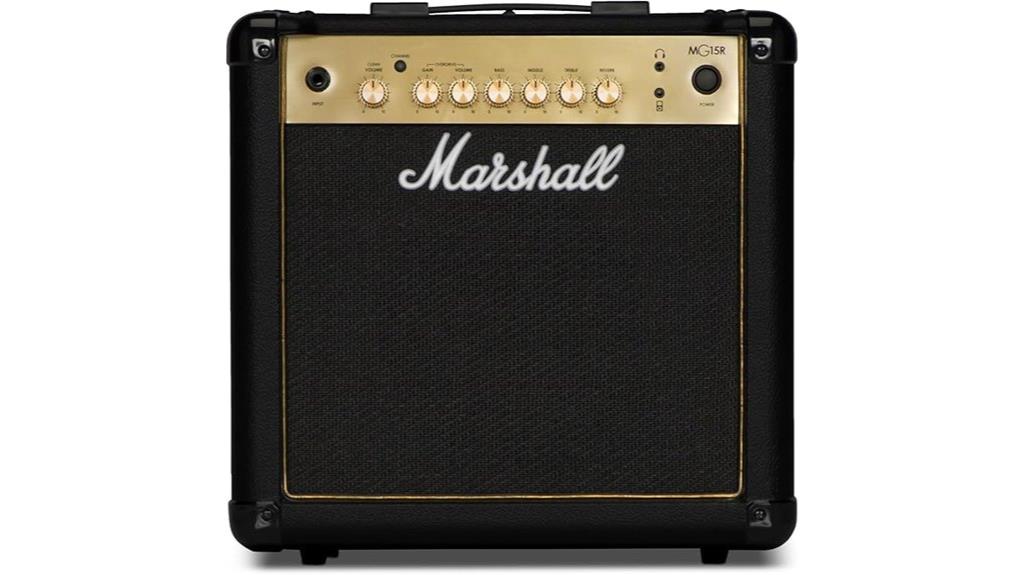
Musicians seeking a reliable practice companion that won’t break the bank will find the Marshall MG15GR delivers impressive versatility in a surprisingly compact package, though I’ll admit it’s not going to replace your main gigging amp anytime soon. You’ll appreciate the two-channel switching capability, which lets you experiment with different tones without killing your practice momentum, while the headphone output keeps the neighbors happy during late-night sessions. The MP3 input proves surprisingly useful for jamming along with tracks, and the emulated speaker output handles home recording duties reasonably well for quick demos and practice recordings.
Best For: Musicians looking for an affordable, compact practice amplifier with versatile features for home use, silent practice, and basic recording needs.
Pros:
- Two-channel switching allows seamless tone experimentation during practice sessions
- Headphone output and MP3 input enable silent practice and play-along functionality
- Compact, portable design with emulated speaker output for convenient home recording
Cons:
- Not suitable as a main gigging amplifier for live performances
- Limited power output at 15W may not satisfy players needing more volume
- May lack the advanced features and tone quality of higher-end practice amps
Marshall MG Gold Series, MG15GFX 15W Guitar Combo Amplifier

Four distinct channels make the Marshall MG15GFX an exceptional choice for guitarists who need versatile tonal options without breaking the bank, delivering everything from pristine cleans to aggressive overdrive in a compact 15-watt package. You’ll find clean tones, gritty crunch, and two overdrive channels (OD1 and OD2) that cover most musical styles, while the three-band EQ gives you precise control over your sound’s character. The headphone output keeps your neighbors happy during late-night practice sessions, and the emulated speaker output makes home recording surprisingly decent. You can jam along with your favorite tracks using the MP3/line input, making this compact amp surprisingly versatile for practice.
Best For: Beginner to intermediate guitarists seeking an affordable, versatile practice amp with multiple channels and recording capabilities for home use and small venue performances.
Pros:
- Four distinct channels (clean, crunch, OD1, OD2) provide excellent tonal versatility for different musical styles
- Headphone output and emulated speaker output enable silent practice and quality home recording
- Compact 15-watt design with MP3/line input makes it highly portable and practical for jamming along with songs
Cons:
- Limited power output may not be sufficient for larger venues or band performances with drums
- As a budget-friendly option, tone quality may not match higher-end tube amplifiers
- Compact size likely means smaller speaker, which could limit overall sound projection and bass response
Marshall MS2 Battery-Powered Micro Guitar Amplifier
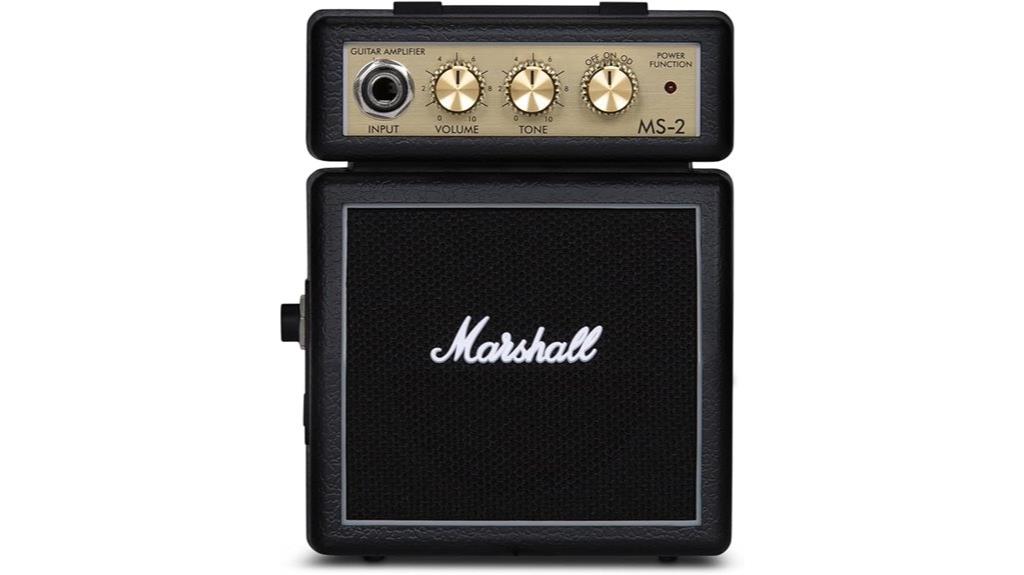
The Marshall MS2’s battery-powered design makes it the perfect choice for guitarists who need genuine Marshall tone without being tethered to a wall outlet, whether you’re practicing in a dorm room, camping trip, or backstage warm-up session. This micro amplifier delivers surprisingly authentic Marshall sound through its single 9V battery operation, offering both clean and overdrive channels with dedicated volume and tone controls that respond well to your guitar’s output adjustments. While its 1-watt power output won’t fill venues, the MS2 excels at quiet practice sessions, particularly when you’re using the headphone jack to avoid disturbing neighbors or family members during late-night playing sessions.
Best For: Beginner to experienced guitarists who need a portable, battery-powered practice amp for quiet sessions in dorms, apartments, or travel situations where traditional amplification isn’t practical.
Pros:
- Authentic Marshall tone in an ultra-compact, portable design that fits easily in a gig bag
- Battery-powered operation with both clean and overdrive channels plus headphone jack for silent practice
- Responsive volume and tone controls that work well with guitar pickup adjustments, especially single-coils
Cons:
- Limited 1-watt output makes it unsuitable for live performances or larger practice spaces
- Sound quality can become distorted and choppy at higher volumes with noticeable vibrations
- Headphone jack requires an adapter for standard 3.5mm headphones, adding an extra component to manage
Factors to Consider When Choosing a Marshall Combo Amp
When I’m helping guitarists choose the right Marshall combo amp, I’ve learned that five key factors consistently make the difference between a satisfying purchase and buyer’s remorse. Power output requirements, speaker size impact, built-in effects options, channel configuration types, and portability considerations each play essential roles in determining whether an amp will meet your specific playing needs, venue requirements, and tonal preferences. I’ll walk you through each factor systematically, providing the technical details and practical insights you need to make an informed decision that matches your playing style, budget constraints, and performance expectations.
Power Output Requirements
Understanding how much power you’ll need from your Marshall combo amp can make the difference between nailing that perfect tone and struggling with inadequate volume or unnecessary bulk. I’ve found that 10-15 watt combos work perfectly for home practice and intimate settings, offering that classic Marshall warmth without rattling your neighbors’ windows. When I need more versatility, 30-watt options provide the sweet spot between bedroom-friendly volumes and small venue performance capabilities. For serious gigging, I’d recommend 50+ watt combos that deliver the headroom and projection needed for larger crowds while maintaining Marshall’s signature clarity. Remember, higher wattage doesn’t automatically mean better tone – speaker configuration and overall design matter just as much.
Speaker Size Impact
Although many players focus primarily on wattage when selecting their Marshall combo, I’ve learned that speaker size plays an equally significant role in shaping your overall sound character, projection capabilities, and practical usability. Marshall’s 10-inch speakers, found in models like the DSL20CR, deliver robust tones with excellent low-end response that works across multiple musical styles, from blues to metal. Smaller 6-inch configurations provide crystal-clear articulation but sacrifice the depth and volume needed for larger rehearsal spaces or gigs. I’ve noticed the trade-off becomes particularly apparent when you’re hauling gear—those compact 6-inch models are considerably lighter for musicians who prioritize portability over maximum sonic impact, while 10-inch speakers offer that fuller, more dynamic sound quality that enhances both practice sessions and live performances.
Built-in Effects Options
The versatility that built-in effects bring to Marshall combo amps has transformed how I approach both practice sessions and live performances, eliminating the need for multiple pedals while maintaining the quality and character that makes Marshall legendary. I’ve found the MG15GFX particularly impressive, offering reverb, chorus, phaser, flanger, and delay through its multi-effects system, with four distinct channels—Clean, Crunch, OD1, and OD2—that provide extensive customization options for different musical styles. The user-friendly controls make shifting between tones seamless during performances, while the headphone outputs allow me to experiment with effects during silent practice sessions without disturbing my neighbors, making these amplifiers exceptionally cost-effective for beginners and solo musicians.
Channel Configuration Types
When choosing between different channel configurations in Marshall combo amps, I’ve discovered that the number and type of channels directly impacts both your creative flexibility and performance capabilities, with each setup offering distinct advantages depending on your musical needs and playing style. Two-channel configurations provide straightforward clean-to-distorted shifts, which I find essential for dynamic genres requiring quick tonal adjustments during performances. Multi-channel amps, featuring up to four channels with separate clean, crunch, and overdrive options, offer superior versatility for players who need diverse tonal palettes without external pedals. What’s particularly valuable is having independent gain and EQ controls per channel, allowing precise customization of each sound. Built-in effects like reverb and delay further enhance these configurations, eliminating the need for additional equipment while maintaining Marshall’s signature responsiveness.
Portability and Weight
Beyond sound quality and channel versatility, I’ve learned that portability can make or break your Marshall amp experience, especially if you’re frequently moving between practice spaces, gigs, or recording sessions. The MG10G-U exemplifies this balance perfectly, weighing just 10 pounds with compact dimensions of 13.9 x 11.77 x 18.5 inches, making it ideal for beginners who need easy transport. For ultimate portability, the MS2 model at 0.34 pounds fits into any gig bag, though I’ll admit it’s more of a practice companion than a performance powerhouse. The MG30GFX-U, while heavier at 23.8 pounds, still maintains reasonable portability for its feature set, and models like the MG15GR prove you don’t need to sacrifice sound quality for lightweight design.
Practice Features Available
Once you’ve found an amp that fits your portability needs, I’ve discovered that practice-specific features often determine how much you’ll actually reach for your Marshall combo amp during those essential daily sessions. The headphone output becomes your best friend when you’re living in close quarters, allowing silent practice without earning dirty looks from roommates or family members. I particularly value auxiliary inputs that let me jam along with backing tracks, turning mundane scale practice into engaging musical sessions. Multiple channels offer the tonal variety I need for different practice styles, whether I’m working on clean chord progressions or dialing in that perfect crunch tone. Built-in effects like reverb and overdrive eliminate the need for additional pedals during practice.
On a final note
I’ve tested countless Marshall combos over the years, and these models consistently deliver the legendary British tone that made Marshall famous. Whether you’re jamming in your bedroom with the MS2 or gigging with the MG30GFX, each amp offers distinct character and reliable performance. Consider your playing style, venue requirements, and budget carefully, because the right Marshall combo will become your trusted companion for years of musical expression. In addition to their iconic sound, these amps are known for their durability and ease of use, making them suitable for both beginners and seasoned players alike. When searching for guitar amps that deliver incredible sound, it’s essential to try them out in different settings to truly appreciate their capabilities. With a variety of tones and effects available, you can effortlessly shape your sound to fit any genre or mood.

